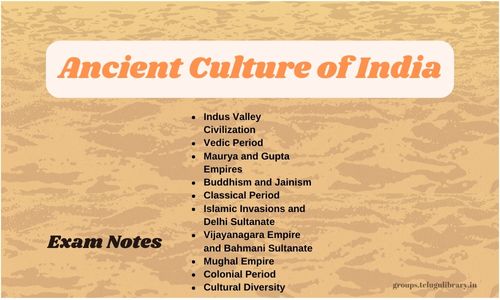Ancient Culture of India…
Ancient Culture of India
Introduction
India, with its rich and diverse ancient culture, has a history that spans thousands of years. From the early civilizations along the Indus River to the Mughal Empire and the colonial period, Indian culture has left an indelible mark on the subcontinent and beyond. Join us on a journey through time as we explore the key aspects of this fascinating culture.
Indus Valley Civilization (circa 3300–1300 BCE)
* The Indus Valley Civilization, flourishing in the Indian subcontinent, showcased remarkable urban planning and advanced drainage systems.
* Cities like Mohenjo-Daro and Harappa epitomized the sophistication of this ancient culture.
* Trade connections with Mesopotamia and a yet-to-be-deciphered writing system titillate the imagination.
Vedic Period (circa 1500–500 BCE)
* The Vedic period gave birth to the sacred texts known as the Vedas, among the oldest religious scriptures in the world.
* Society was organized into four varnas or social classes: the Brahmins, Kshatriyas, Vaishyas, and Shudras.
* Core concepts such as dharma (duty) and karma (action and consequence) became the philosophical pillars of this era.
Maurya and Gupta Empires (322 BCE – 550 CE)
* The Maurya Empire, under Chandragupta Maurya and Ashoka, witnessed political unity and the propagation of Buddhism.
* The Gupta Empire, known as the “Golden Age,” fostered advancements in science, mathematics, art, and literature.
Buddhism and Jainism
* Buddhism and Jainism emerged as prominent religious movements during this period, emphasizing non-violence, compassion, and the pursuit of enlightenment.
Ancient Culture of India….
Classical Period (500–1200 CE)
* The classical period in Indian history was a golden era for art, literature, and music.
* Notable works from this time include Kalidasa’s plays, poetry, and the treatise on music known as Natya Shastra.
* Imposing temples, such as those in Khajuraho and Ellora, stand as testaments to the remarkable religious and artistic achievements of this era.
Islamic Invasions and the Delhi Sultanate (12th–16th centuries)
* The advent of Islam in India brought new cultural influences, including Persian architecture and the Urdu language.
* The Delhi Sultanate marked the beginning of an Islamic period in Indian history.
Vijayanagara Empire (1336–1646) and Bahmani Sultanate
* The Vijayanagara Empire in the south and the Bahmani Sultanate in the Deccan witnessed an intriguing amalgamation of Hindu and Islamic cultures.
Mughal Empire (1526–1857)
* The Mughal Empire made an indelible mark on Indian art and architecture, most notably with the stunning creations of the Taj Mahal and the Red Fort.
* Akbar’s reign stands out for his efforts to embrace religious tolerance and promote cultural syncretism.
Colonial Period (17th–20th centuries)
* British colonial rule had a profound influence on Indian culture, especially in the realms of education, administration, and modernization.
* The struggle for independence, led by visionary figures like Mahatma Gandhi, ignited a sense of cultural pride and championed non-violent resistance.
Ancient Culture of India….
Cultural Diversity
* India, a land of immense diversity, is home to a tapestry of cultures, languages, and traditions.
* The coexistence of multiple religions, including Hinduism, Islam, Buddhism, Jainism, Sikhism, and more, has enriched the vibrancy of Indian culture.
Conclusion
The ancient culture of India stands as a testament to the continuity, resilience, and adaptability of a civilization that has absorbed influences over millennia.
From the ingenuity of the Indus Valley Civilization to the artistic splendor of the Mughal Empire, it has etched a lasting legacy that shapes the identity of modern India. Join us on this enchanting journey through time, as we delve further into the depths of India’s captivating past.
Indian constitution New challenges Notes With Questions and Answers
“Distinctive Features of Indian Federalism: Student-Friendly Question & Answers”
What are Fundamental Duties class 9-Question and Answers
What do you mean by Directive Principles of State Policy?
Understanding Fundamental Rights in the Indian Constitution – Exam Study Material
“Tribute to Sarvepalli Radhakrishnan: The Philosopher-President Who Shaped India’s Future”
What is India’s uniform civil code? History of Uniform Civil Code India and Questionnaire
7th schedule of constitution of India
